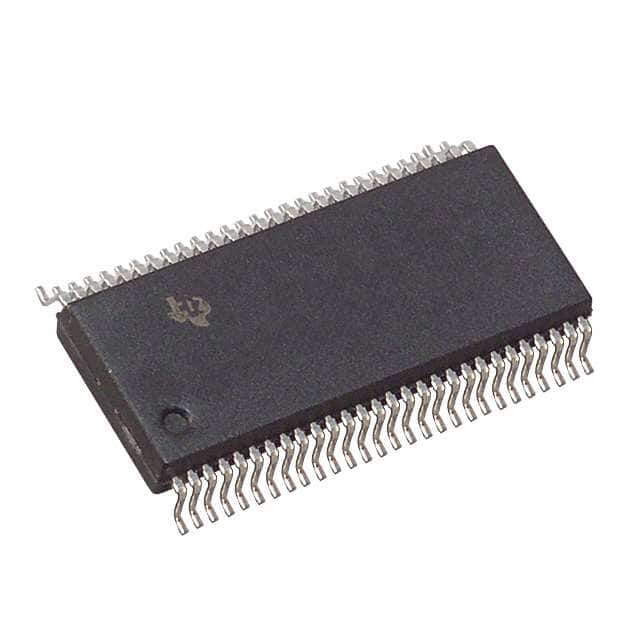Viz Specifikace pro podrobnosti o produktu.

SN74LVTH16646DL
Overview
- Category: Integrated Circuit (IC)
- Use: Logic Level Translator
- Characteristics: High-speed, low-voltage, 16-bit bus transceiver with 3-state outputs
- Package: TSSOP (Thin Shrink Small Outline Package)
- Essence: Translates signals between different voltage levels in digital systems
- Packaging/Quantity: Available in reels of 2500 units
Specifications
- Supply Voltage Range: 2.7V to 3.6V
- Input Voltage Range: 0V to VCC
- Output Voltage Range: 0V to VCC
- Operating Temperature Range: -40°C to +85°C
- Maximum Propagation Delay: 4.5ns
- Maximum Operating Frequency: 200MHz
Pin Configuration
The SN74LVTH16646DL has a total of 56 pins, which are divided into four groups:
- Group A (Pins 1-14): Data Inputs/Outputs (D1-D14)
- Group B (Pins 15-28): Control Inputs (G, OE*)
- Group C (Pins 29-42): Data Inputs/Outputs (D15-D28)
- Group D (Pins 43-56): Control Inputs (G, OE*)
Functional Features
- Bidirectional voltage translation between two independent buses
- Supports mixed-mode signal operation on each port
- 3-state outputs for bus isolation when disabled
- Provides both level shifting and bus buffering capabilities
- Low power consumption
- ESD protection on all inputs and outputs
Advantages and Disadvantages
Advantages: - High-speed operation allows for efficient data transfer - Wide supply voltage range enables compatibility with various systems - 3-state outputs provide flexibility in bus design - ESD protection ensures reliability in harsh environments
Disadvantages: - Limited number of data inputs/outputs (28 in total) - Not suitable for applications requiring higher voltage translation levels - Relatively small package size may pose challenges in certain designs
Working Principles
The SN74LVTH16646DL operates by receiving data from one bus and translating it to the voltage level required by another bus. The control inputs (G, OE*) determine the direction of data flow and enable/disable the outputs. When the outputs are disabled, they enter a high-impedance state, allowing other devices to drive the bus.
Detailed Application Field Plans
The SN74LVTH16646DL is commonly used in various digital systems that require voltage level translation. Some specific application fields include:
- Microcontrollers: Facilitates communication between microcontrollers operating at different voltage levels.
- Memory Interfaces: Enables data transfer between memory modules with varying voltage requirements.
- Communication Systems: Allows for signal conversion between different communication protocols.
- Industrial Automation: Used in PLCs (Programmable Logic Controllers) to interface with sensors and actuators operating at different voltage levels.
Alternative Models
- SN74LVC4245A: 8-bit bidirectional voltage translator with automatic direction sensing.
- TXB0108PWR: 8-bit non-inverting translator with 3-state outputs.
- PCA9306DCUR: Dual bidirectional I2C-bus and SMBus voltage-level translator.
These alternative models offer similar functionality and can be considered as substitutes for the SN74LVTH16646DL in different applications.
Word count: 439 words
Seznam 10 běžných otázek a odpovědí souvisejících s aplikací SN74LVTH16646DL v technických řešeních
Sure! Here are 10 common questions and answers related to the application of SN74LVTH16646DL:
Q: What is SN74LVTH16646DL? A: SN74LVTH16646DL is a 16-bit bus transceiver with 3-state outputs, designed for low-voltage (3.3V) applications.
Q: What is the purpose of SN74LVTH16646DL? A: SN74LVTH16646DL is used to enable bidirectional data transfer between two buses with different voltage levels.
Q: What is the maximum operating frequency of SN74LVTH16646DL? A: The maximum operating frequency of SN74LVTH16646DL is typically around 200 MHz.
Q: What is the voltage range supported by SN74LVTH16646DL? A: SN74LVTH16646DL supports a voltage range from 2.7V to 3.6V.
Q: How many channels does SN74LVTH16646DL have? A: SN74LVTH16646DL has 16 bidirectional channels.
Q: Can SN74LVTH16646DL be used in both parallel and serial communication systems? A: Yes, SN74LVTH16646DL can be used in both parallel and serial communication systems.
Q: Does SN74LVTH16646DL support hot-swapping capability? A: No, SN74LVTH16646DL does not support hot-swapping capability. It is recommended to power down the device before connecting or disconnecting it.
Q: What is the typical propagation delay of SN74LVTH16646DL? A: The typical propagation delay of SN74LVTH16646DL is around 3.5 ns.
Q: Can SN74LVTH16646DL be used in high-speed data transmission applications? A: Yes, SN74LVTH16646DL can be used in high-speed data transmission applications due to its low propagation delay and high operating frequency.
Q: What are the recommended decoupling capacitor values for SN74LVTH16646DL? A: It is recommended to use a 0.1 µF ceramic capacitor placed as close as possible to the VCC and GND pins of SN74LVTH16646DL.
Please note that these answers are general and may vary depending on specific application requirements.

